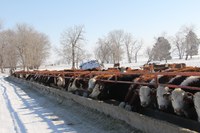Don’t Skimp on Protein for Pregnant Cows
(Click the image below to view a high-resolution image that can be downloaded)
Underfeeding protein to stock cows through their winter gestation has serious consequences, a North Dakota State University Extension livestock expert warns.
“If insufficient protein and nitrogen are provided and degraded in the rumen, forage digestion will be reduced and the cow may not meet caloric needs and lose weight,” says John Dhuyvetter, Extension livestock systems specialist at the North Central Research Extension Center near Minot, N.D. “Furthermore, the developing fetus may be undernourished, impacting development, vigor and survival at birth, and future outcomes. Both colostrum and milk quality and quantity can suffer.”
Typical mature, late-gestation cows weighing about 1,400 pounds will need approximately 2.5 pounds of protein intake a day. Some 60 to 70 percent of the protein should break down in the rumen to supply sufficient nitrogen for rumen microbes.
The remaining 30 to 40 percent of the protein that’s undegraded in the rumen and bypasses to the lower gut, along with microbial-passed protein, will supply the cow and growing fetus with required amino acids and protein. At full intake, this equates to 7 to 8 percent crude protein in the diet.
“This won’t always be quite enough, depending on both the feeds being used and the cows being fed,” Dhuyvetter notes. “Certainly for younger cows still growing and developing muscle and skeletal tissue (and associated with less intake), an 8 to 9 percent crude protein ration is needed.”
He adds that feeds high in bypass protein such as distillers grains or low in protein digestibility such as straw require feeding at a higher level of protein formulation to make sure rumen fermentation is maximized.
Producers have many options and feeds for supplementing protein to inadequate rations. One of the easiest is to include a higher-protein hay such as alfalfa with lower-protein grass and silage.
Byproduct feeds are another option. They have concentrated protein levels and can be limit-fed to supply added protein. Often, protein supplied at .3 to .5 pound per day fixes deficiencies.
“The appropriate feeding rate depends on the protein level in the supplemental feed and what’s needed to meet the cow’s requirement,” Dhuyvetter explains.
For example, a cow receiving a silage and straw ration having a 6.5 percent crude protein level will need .5 pound of added protein to bring the ration up to 8 percent crude protein. This can be met with 1.3 pounds of canola meal at 39 percent crude protein or 1.8 pounds of dried distillers grains at 28 percent crude protein.
Contact Dhuyvetter at 701-857-7682 or john.dhuyvetter@ndsu.edu for more information.
NDSU Agriculture Communication - Jan. 7, 2019
| Source: | John Dhuyvetter, 701-857-7682, john.dhuyvetter@ndsu.edu |
|---|---|
| Editor: | Ellen Crawford, 701-231-5391, ellen.crawford@ndsu.edu |


